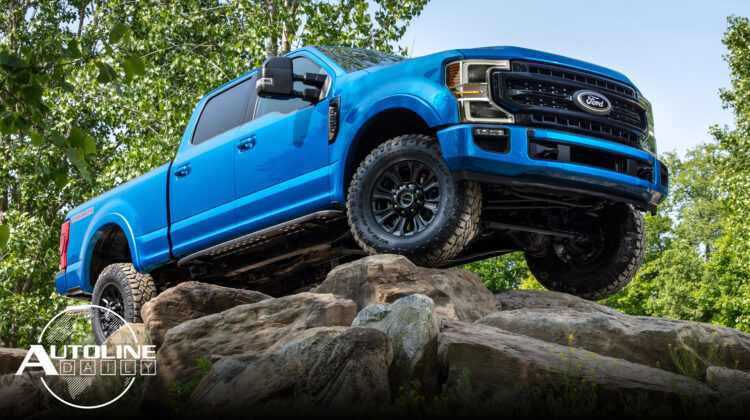
Follow us on social media:
Runtime: 7:24
0:06 Auto Industry Entering Profit Desert
0:47 Ford Announces Big Cuts in Europe
1:09 VW Could Make Billions on Truck IPO
1:40 Automakers Face Huge Emission Fines in Europe
2:43 Audi Refreshes the Q7
3:19 Boeing Teams with Kitty Hawk on VTOLs
3:50 Tremor is Ford’s New Off-Road Super Duty
4:52 Widebody Package Now Available on Dodge Charger
5:37 Tesla Needs to Go All Out for Production Record
6:03 Does Tesla Have a Secret Battery Lab?
Visit our sponsors to thank them for their support of Autoline Daily: Bridgestone and DuPont.
This is Autoline Daily reporting on the global automotive industry.
AUTO INDUSTRY ENTERING PROFIT DESERT
Wow, you can’t look at the news today and not come away thinking that the auto industry has hit a massive period of disruption. Alix Partners predicts the industry is entering what it calls a “profit desert.” EBIT margins have fallen from 5.7% in 2017 to 4.6% today and are headed lower. And automaker’s return on capital employed is down to only 2.8%–which is where it was just before the Great Recession. Alix Partners warns that automakers only have a few months to take action to transform their investments and operations if they want to survive the coming downturn.
FORD ANNOUNCES BIG CUTS IN EUROPE
In an action that is directly related to that Ford announced today that it is slashing 20% of its European workforce. It’s closing 6 manufacturing plants and getting rid of 12,000 employees. Even with these cuts, analysts says Ford will have a very tough time meeting its profit targets for Europe.
VW COULD MAKE BILLIONS ON TRUCK IPO
Meanwhile Volkswagen is raising cash by selling stock in an IPO of its truck operations. VW’s truck operations which operates under the name Traton includes Scania, MAN and VW’s own trucks made in Brazil. The IPO will raise $1.8 billion. And VW’s board will vote this month to possibly approve an alliance with Ford which will include co-operation on commercial vans, mid-size pickups and autonomous cars.
AUTOMAKERS FACE HUGE EMISSION FINES IN EUROPE
And here’s another tidal wave about to slam the Europeean industry. Jato Dynamics says European automakers could be fined as much as $39 billion by missing emission targets. By 2021 automakers must average 95 grams of CO2 per kilometer. But they’re struggling to meet that goal, especially Volkswagen, PSA and FCA. The findings are based on 2018 emission levels and don’t take into account upcoming EVs models. But EV sales will probably be too small to make up the difference. Even worse, automotive emissions in Europe have actually been going up for the last two years.
AUDI REFRESHES THE Q7
Audi took a fairly standard approach to refreshing the Q7. It prettied up the front and rear ends while pretty much everything in-between stays the same. The interior was substantially updated, but it’s nearly a carbon copy of the Q8. Depending on the market, the Q7 will be available with two diesel, one gasoline and one plug-in hybrid powertrain. The gas and diesel will be available with 48-volt technology as well. And all are mated to an 8-speed automatic transmission and all-wheel drive. It launches in Europe in September.
BOEING TEAMS WITH KITTY HAWK ON VTOLs
Boeing is expanding its reach into vertical takeoff and landing aircraft, or VTOLs for short. It formed a partnership with a company called Kitty Hawk to collaborate on urban air mobility, or what we’ll call passenger drones. The two companies are using Kitty Hawk’s Cora aircraft, which is a two-person air taxi and has 13 rotors. The plan is to make these VTOLs autonomous and they are developing the safety and regulatory ecosystem that will be needed for them.
TREMOR IS FORD’S NEW OFF-ROAD SUPER DUTY
Ford added a new off-road package for its Super Duty truck, called Tremor. One of the first giveaways are massive 35-inch Goodyear tires mounted on unique 18-inch wheels. The front end was lifted 2-inches on progressive rate springs and large twin-tube dampers, with a rear stabilizer bar tuned to the new springs. A locking rear differential is out back, while a limited slip differential is up front. Off-road running boards and skid plates ensure the truck can shrug off nearly any obstacle. Another unique feature is a rock crawl mode that has been added to the selectable drive modes. The Tremor package is available on XLT, Lariat, King Ranch or Platinum F-250s and -350s with either the 7.3L gas V8 or PowerStroke diesel, 4X4 and single rear wheel. It launches later this year. But so far no word on what it will cost.
WIDEBODY PACKAGE NOW AVAILABLE WITH 4-DOORS
The widebody package that was previously only available on the Challenger Hellcat, is now being offered on the Charger Hellcat. It includes integrated fender flares, wider wheels and tires, Brembo front brakes and unique suspension tuning with Bilstein shocks. The package will be standard on all Charger Hellcats and available on Charger Scat Pack. It’s currently a $6,000 option for Challenger Hellcats.
TESLA NEEDS TO GO ALL OUT FOR PRODUCTION RECORD
In the fourth quarter of 2018, Tesla delivered a record 90,700 vehicles to customers. Now Elon Musk says the company could break that record this quarter but it must go “all out” to reach that goal. The company previously forecasted it would deliver between 90,000 and 100,000 vehicles this quarter after delivering only 63,000 in the first quarter.
DOES TESLA HAVE A SECRET BATTERY LAB?
In other Tesla news, CNBC reports that the company has a secret battery lab near its plant in Fremont, California that’s working on developing battery cells. This would help Tesla reduce its dependence on Panasonic, which manufactures battery cells for the automaker. And this news falls in line with Elon Musk’s goal of making the company as vertically integrated as possible.
With all this EV development, how long can the ICE survive? That will be one of the topics on Autoline After Hours later this afternoon. James Martin, a powertrain analyst from IHS Markit will be joining us. So will Lindsay Brooke from SAE Engineering. So join us at 3 pm eastern time on our website or YouTube channel as we try to figure out when electrons will replace pistons.
And a programming note before I sign off, Autoline Daily will be off all next week as the crew takes a well deserved break for the 4th of July holiday.
But that brings us to the end of today’s show, thanks for watching and we’ll see you tomorrow.
Thanks to our partner for embedding Autoline Daily on its website: WardsAuto.com

John McElroy is an influential thought leader in the automotive industry. He is a journalist, lecturer, commentator and entrepreneur. He created “Autoline Daily,” the first industry webcast of industry news and analysis.




